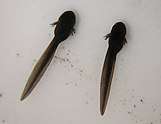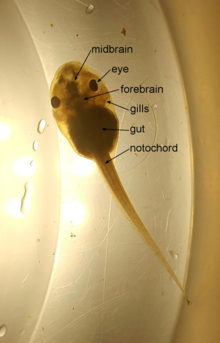Tadpole
A tadpole (also called a pollywog) is the larval stage in the life cycle of an amphibian. Most tadpoles are fully aquatic, though some species of amphibians have tadpoles that are terrestrial. Tadpoles have some features that may not be found in adult amphibians such as a lateral line, gills, and tails. As they undergo metamorphosis, the diet of tadpoles changes and they will start to breathe air.
Having no hard parts, it might be expected that fossil tadpoles would not exist. However, traces of biofilms have been preserved and fossil tadpoles have been found dating back to the Miocene. Tadpoles are eaten in some parts of the world and are mentioned in various folk tales from around the world.
Etymology
The name tadpole is from Middle English taddepol, made up of the elements tadde, 'toad', and pol, 'head' (modern English poll). Similarly, pollywog / polliwog is from Middle English polwygle, made up of the same pol, 'head', and wiglen, 'to wiggle'.[1]
General description
The life cycle of all amphibians involve a larval stage that is intermediate between embryo and adult. Tadpoles of frogs are mostly herbivorous, while tadpoles of salamanders and caecilians are carnivorous.
Anura

Tadpoles of frogs and toads are usually globular, with a laterally compressed tail and internal gills. When first hatched, anuran tadpoles have external gills that are eventually covered by skin. Newly hatched tadpoles are also equipped with a cement gland which allows them to attach to objects. The tadpoles have a cartilaginous skeletons and a notochord which eventually develops into a proper spinal cord. Most tadpoles have a flattened tail with which they swim by lateral undulation. Tadpoles have spiracles through which water exits the opercular chamber. Depending on the species, there can be two spiracles on both sides of the body, a single spiracle on the underside near the vent, or a single spiracle on the left side of the body.[2]

Anuran tadpoles are usually herbivorous, feeding on soft decaying plant matter. The gut of most tadpoles is long and spiral shaped to efficiently digest organic matter, and can be seen through the bellies of many species. Though many tadpoles will feed on dead animals if it is available to them, only a few species of frog have strictly carnivorous tadpoles. An example being the frogs of the family Ceratophryidae, their cannibalistic tadpoles having wide gaping mouths with which they devour other organisms, including other tadpoles. Another example is the tadpoles of the New Mexico spadefoot toad (Spea multiplicata) which will develop a carnivorous diet along with a broader head, larger jaw muscles, and a shorter gut if food is scarce, allowing them to consume fairy shrimp and their smaller herbivorous siblings.[3] A few genera such as Pipidae and Microhylidae have species whose tadpoles are filter feeders that swim through the water column feeding on plankton.

As a frog tadpole matures it gradually develops its limb, with the back legs growing first and the front legs second. The tail is absorbed into the body using apoptosis. Lungs develop around the time as the legs start growing, and tadpoles at this stage will often swim to the surface and gulp air. During the final stages of metamorphosis, the tadpole's mouth changes from a small, enclosed mouth at the front of the head to a large mouth the same width as the head. The intestines shorten as they transition from a herbivorous diet to the carnivorous diet of adult frogs.
Tadpoles vary greatly in size, both during their development and between species. For example, in a single family, Megophryidae, length of late-stage tadpoles varies between 3.3 centimetres (1.3 in) and 10.6 centimetres (4.2 in).[4] The tadpoles of the paradoxical frog (Pseudis paradoxa) can reach up to 27 centimetres (11 in),[5] the longest of any frog[6], before shrinking to a mere snout-to-vent length of 3.4–7.6 cm (1.3–3.0 in).
While most anuran tadpoles inhabit wetlands, ponds, vernal pools, and other small bodies of water with slow moving water, a few species are adapted to different environments. Some frogs have terrestrial tadpoles, such as the family Ranixalidae, whose tadpoles are found in wet crevices near streams. The tadpoles of Micrixalus herrei are adapted to a fossorial lifestyle, with a muscular body and tail, eyes covered by a layer of skin, and reduced pigment.[7] Several frogs have stream dwelling tadpoles equipped with a strong oral sucker that allows them to hold onto rocks in fast flowing water, two examples being the Indian purple frog (Nasikabatrachus sahyadrensis) and the tailed frogs (Ascaphus) of Western North America.
Some anurans will provide parental care towards their tadpoles. Frogs of the genus Afrixalus will lay their eggs on leaves above water, folding the leaves around the eggs for protection. Female Pipa frogs will embed the eggs into their backs where they get covered by a thin layer of skin. The eggs will hatch underneath her skin and grow, eventually leaving as either large tadpoles (such as in Pipa parva) or as fully formed froglets (Pipa pipa). Female marsupial frogs (Hemiphractidae) will carry eggs on her back for various amounts of time, with it going as far as letting the tadpoles develop into tiny froglets in a pouch. Male African bullfrogs (Pyxicephalus adspersus) will keep watch over their tadpoles, attacking anything that might be a potential threat, even though he may eat some of the tadpoles himself.[8] Males of the Emei mustache toads (Leptobrachium boringii) will construct nests along riverbanks where they breed with females and keep watch over the eggs, losing as much as 7.3% of their body mass in the time they spend protecting the nest.[9] Male midwife toads (Alytes) will carry eggs between their legs to protect them from predators, eventually releasing them into a body of water when they are ready to hatch. Poison dart frogs (Dendrobatidae) will carry their tadpoles to various locations, usually phytotelma, where they remain until metamorphosis. Some female dart frogs such as the strawberry poison dart frog (Oophaga pumilio) will regularly lay unfertilized eggs for the developing tadpoles to feed on.[10]
Fossil record
Despite their soft-bodied nature and lack of mineralised hard parts, fossil tadpoles (around 10 cm in length) have been recovered from Upper Miocene strata.[11] They are preserved by virtue of biofilms, with more robust structures (the jaw and bones) preserved as a carbon film.[12] In Miocene fossils from Libros, Spain, the brain case is preserved in calcium carbonate, and the nerve cord in calcium phosphate. Other parts of the tadpoles' bodies exist as organic remains and bacterial biofilms, with sedimentary detritus present in the gut.[11] Tadpole remains with telltale external gills are also known from several labyrinthodont groups.
Human use
Some tadpoles are used as food. Tadpoles of megophryid frog Oreolalax rhodostigmatus are particularly large, more than 10 cm (3.9 in) in length,[4] and are collected for human consumption in China.[13] In India, Clinotarsus curtipes are collected for food,[14] and in Peru Telmatobius mayoloi tadpoles are collected for food and medicine.[15]
Mythology and history
According to Sir George Scott, in the origin myths of the Wa people in China and Myanmar, the first Wa originated from two female ancestors Ya Htawm and Ya Htai, who spent their early phase as tadpoles ("rairoh") in a lake in the Wa country known as Nawng Hkaeo.[16]
In the Ancient Egyptian numerals, a hieroglyphic representing a tadpole was used to denote the value of 100,000.
References
- "The Grammarphobia Blog: On tadpoles and pollywogs". 2012-05-01. Archived from the original on 2016-08-22. Retrieved 2016-08-08.
The word is a compound of the Middle English tade or tadde (toad) and, apparently, the noun "poll" (head or roundhead), Oxford says. [...] Its earliest appearance in writing - spelled "polwygle" - is from 1440, the OED says. That very odd-looking word was originally derived, Oxford says, from "poll" plus "wiggle".
- "North American Tadpoles Spiracle". Archived from the original on 28 December 2016. Retrieved 12 April 2020.
- Pfennig, David (1990). "The adaptive significance of an environmentally-cued developmental switch in an anuran tadpole". Oecologia. 85 (1): 101–107. Bibcode:1990Oecol..85..101P. doi:10.1007/BF00317349. PMID 28310961.
- Li, Cheng; Guo, Xian-Guang; Wang, Yue-Zhao (2011). "Tadpole types of Chinese megophryid frogs (Anura: Megophryidae) and implications for larval evolution". Current Zoology. 57 (1): 93–100. doi:10.1093/czoolo/57.1.93.
- Bokermann, W.C.A. (1967). "Girinos de anfíbios brasileiros—3: sôbre um girino gigante de Pseudis paradoxa (Amphibia, Pseudidae)". Revista Brasileira de Biologia. 27: 209–212.
- Crump, Martha L. (2009). "Amphibian diversity and life history" (PDF). Amphibian Ecology and Conservation. A Handbook of Techniques: 3–19. Archived from the original (PDF) on 2011-07-15.
- Senevirathne, Gayani; Garg, Sonali; Kerney, Ryan; Meegaskumbura, Madhava; Biju, S. D. (30 March 2016). "Unearthing the Fossorial Tadpoles of the Indian Dancing Frog Family Micrixalidae". PLOS One. 11 (3): e0151781. Bibcode:2016PLoSO..1151781S. doi:10.1371/journal.pone.0151781. PMC 4814069. PMID 27027870.
- Cook, Ferguson, Telford, C.L., J.W.H., S.R. (June 2001). "Adaptive Male Parental Care in the Giant Bullfrog, Pyxicephalus adspersus". Journal of Herpetology. 35 (2): 310–315. doi:10.2307/1566122. JSTOR 1566122.CS1 maint: multiple names: authors list (link)
- Zheng, Li, Deng, Fu, Yuchi, Shuiqang, Duncan, Jinzhong (April 2010). "Aspects of the breeding biology of the Omei mustache toad (Leptobrachium boringii): Polygamy and paternal care". Amphibia-Reptilia. 31 (2): 183–194. doi:10.1163/156853810791069092 – via ResearchGate.CS1 maint: multiple names: authors list (link)
- Brandt, Pröhl, Annely, Heike (April 2002). "Female activity patterns and aggressiveness in the strawberry poison frog Dendrobates pumilio (Anura: Dendrobatidae)". Amphibia-Reptilia. 23 (2): 129–140. doi:10.1163/156853802760061778 – via ResearchGate.
- McNamara, M. E.; Orr, P. J.; Kearns, S. L.; Alcalá, L.; Anadón, P.; Peñalver-Mollá, E. (2009). "Exceptionally preserved tadpoles from the Miocene of Libros, Spain: ecomorphological reconstruction and the impact of ontogeny upon taphonomy". Lethaia. 43 (3): 290–306. doi:10.1111/j.1502-3931.2009.00192.x. hdl:10261/141680.
- McNamara, M. E.; Orr, P. J.; Kearns, S. L.; Alcalá, L.; Anadón, P.; Peñalver-Mollá, E. (2006). Taphonomy of exceptionally preserved tadpoles from the Miocene Libros fauna, Spain: Ontogeny, ecology and mass mortality (PDF). The Palaeontological Association 50th Annual Meeting. The Palaeontological Association. Archived from the original (PDF) on 2011-07-27.
- Fei, L.; Wu, G. (2004). "Oreolalax rhodostigmatus". IUCN Red List of Threatened Species. 2004: e.T57600A11660007. doi:10.2305/IUCN.UK.2004.RLTS.T57600A11660007.en. Archived from the original on 17 August 2016.
- Biju, S.D.; Dutta, S.; Inger, R. (2004). "Clinotarsus curtipes". IUCN Red List of Threatened Species. 2004: e.T58583A11789937. doi:10.2305/IUCN.UK.2004.RLTS.T58583A11789937.en. Archived from the original on 28 December 2017.
- Javier Icochea; Edgar Lehr (2004). "Telmatobius mayoloi". IUCN Red List of Threatened Species. 2004. Retrieved 23 October 2013.CS1 maint: ref=harv (link)
- Scott, James George, Sir. 1935. The Wa or Lawa: Head-Hunters. In Burma and Beyond. p. 292
Further reading
| Wikimedia Commons has media related to Tadpole. |
| Look up tadpole in Wiktionary, the free dictionary. |
- McDiarmid, Roy W.; Altig, Ronald, eds. (1999). Tadpoles: the Biology of Anuran Larvae. Chicago: University of Chicago Press. ISBN 0226557634.